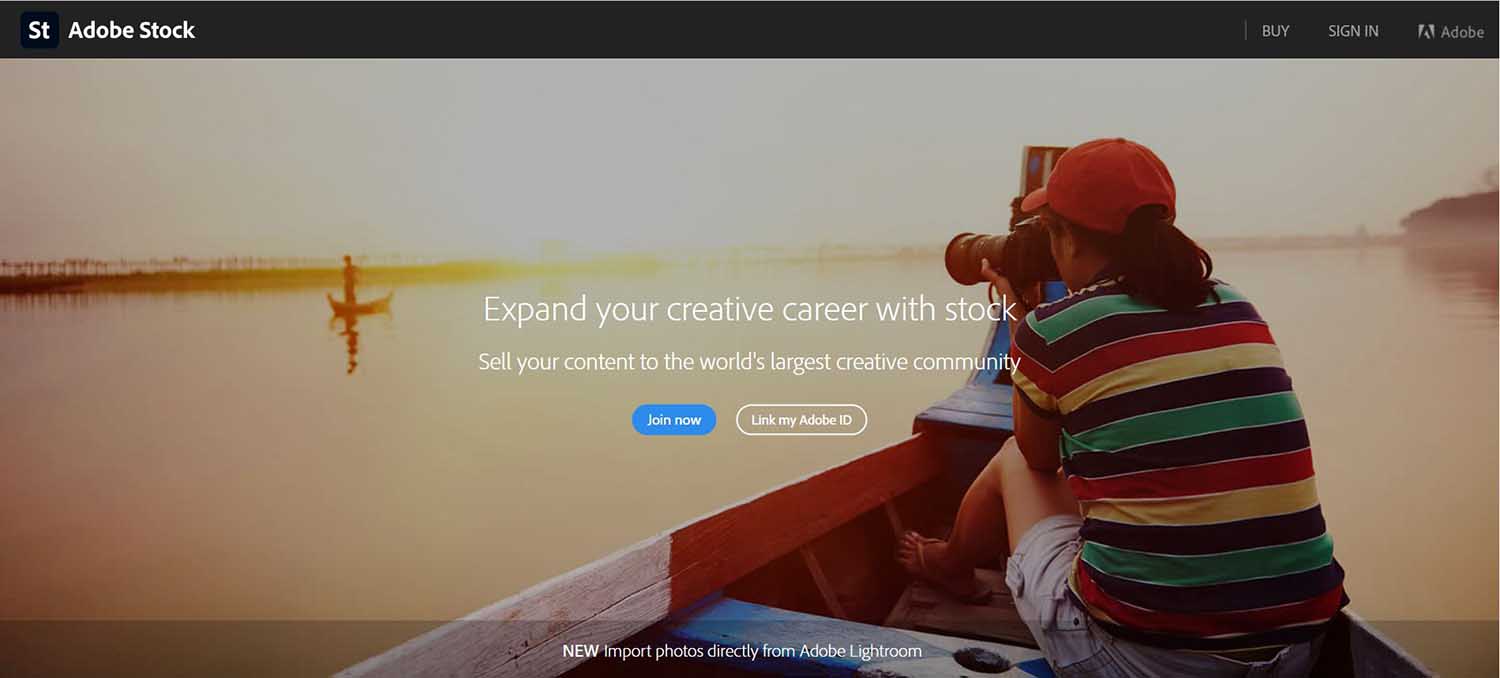Warning: Undefined array key 7 in /home/imgpanda.com/public_html/wp-content/themes/astra/template-parts/single/single-layout.php on line 176
Warning: Trying to access array offset on value of type null in /home/imgpanda.com/public_html/wp-content/themes/astra/template-parts/single/single-layout.php on line 179
Introduction
In today's digital age, creative individuals have found innovative ways to turn their passion for photography, videography, and graphic design into a source of income. One such avenue that has gained immense popularity is contributing content to stock marketplaces. Adobe Stock, a prominent player in this arena, offers a platform where contributors can showcase and sell their work to a global audience. However, before embarking on this creative journey, it's crucial to understand the potential earnings that can be generated as a contributor.
As with any endeavor, knowledge is power. Aspiring contributors need insights into how much they can realistically earn, the factors that influence their earnings, and the strategies they can employ to maximize their income. This blog post aims to provide a comprehensive guide to understanding the potential earnings on Adobe Stock. Whether you're a seasoned contributor looking to enhance your earnings or a newcomer exploring the world of stock content, this post will equip you with the information you need to make informed decisions and achieve success on Adobe Stock. So, let's dive in and unravel the exciting possibilities that await contributors in the realm of stock content creation.
Also Read This: Adding Flaticon Icons to HTML: A Quick Guide
Becoming an Adobe Stock Contributor
Before you can start earning on Adobe Stock, you need to take the first step: becoming a contributor. This section will walk you through the process of joining the Adobe Stock community and getting your content ready for submission.
A. Contributor Registration Process
Becoming an Adobe Stock contributor is a straightforward process that involves creating an account and submitting some basic information. Here's how you can get started:
- Account Creation: Visit the Adobe Stock contributor portal and sign up for an account using your Adobe ID. If you don't have an Adobe ID, you'll need to create one.
- Profile Setup: Fill out your contributor profile, providing information about yourself and your creative background. This profile will help potential buyers learn more about you and your work.
- Legal Agreements: Review and accept the contributor agreement, which outlines the terms and conditions of your participation in the Adobe Stock program.
B. Submission and Approval Guidelines for Content Types
Adobe Stock accepts a wide range of content types, including photos, illustrations, vectors, videos, and templates. To ensure your content is approved and ready for sale, follow these submission guidelines:
- Quality Standards: Your content must meet high-quality standards. This includes technical aspects such as resolution, focus, lighting, and composition. Pay attention to details to ensure your work stands out.
- Model and Property Releases: If your content features recognizable people or private properties, you'll need signed model and property releases to grant permission for commercial use.
- Keywords and Descriptions: Accurate and relevant keywords and descriptions are essential for customers to find your content. Use descriptive keywords that accurately reflect the subject matter.
- Categorization: Properly categorize your content to ensure it appears in relevant search results. Choose categories and tags that best represent the content's theme.
- Exclusivity and Non-Exclusivity: Decide whether you want to contribute exclusively to Adobe Stock or if you'll submit the same content to other stock platforms. Exclusive contributors may have access to higher royalty rates.
- Editorial Content: If your content includes recognizable people, places, or brands and is intended for editorial use, ensure you provide accurate and detailed captions and descriptions.
- File Formats: Submit your content in the appropriate file formats specified by Adobe Stock, ensuring compatibility with various applications and platforms.
Once you've prepared your content according to these guidelines, submit it for review. Adobe Stock's review process ensures that only high-quality and commercially viable content makes it to the marketplace.
By following these steps, you'll be well on your way to becoming a contributor on Adobe Stock and getting your creative work in front of a global audience of potential buyers. Stay tuned as we delve deeper into the factors that determine your earnings as an Adobe Stock contributor.
[caption id="attachment_192133" align="alignnone" width="1500"] Becoming an Adobe Stock Contributor[/caption]
Becoming an Adobe Stock Contributor[/caption]
Also Read This: How to Add a Description in Behance
Factors Affecting Earnings on Adobe Stock
As an Adobe Stock contributor, understanding the elements that influence your earnings is essential for optimizing your success. This section delves into the key factors that impact your potential income on the platform.
A. Quality of Content
- Technical Excellence: High-resolution images and videos are crucial for attracting buyers. Sharpness, lighting, and overall image quality contribute to customer satisfaction.
- Artistic Appeal: Creative compositions and unique perspectives catch the eye. Strive for images that stand out in a crowded marketplace.
B. Relevance and Demand
- Content Trends: Keeping an eye on emerging trends allows you to create content that aligns with current demands and maximizes your exposure.
- Diverse Themes: Cater to a broad range of themes and subjects to attract a wider audience. Meeting varied customer needs increases your chances of sales.
C. Quantity of Content
- Consistent Uploads: Regularly adding new content keeps your portfolio fresh and relevant. An active presence draws more attention from potential buyers.
- Portfolio Size: A larger portfolio increases your chances of being discovered. A diverse range of content increases your overall appeal to different buyers.
Understanding these factors empowers you to make informed decisions about your content creation strategy, cater to customer preferences, and navigate the evolving landscape of the Adobe Stock marketplace.
[caption id="attachment_192134" align="alignnone" width="1500"] Factors Affecting Earnings on Adobe Stock[/caption]
Factors Affecting Earnings on Adobe Stock[/caption]
Also Read This: WWE Classic Matches Reviewed – The Winner of the 2001 Royal Rumble
Pricing and Royalties
Understanding how your earnings are calculated on Adobe Stock involves grasping the pricing models and royalty rates. This section will break down the pricing structure, royalty percentages, and the impact of exclusive and non-exclusive contributor agreements.
A. Adobe Stock Pricing Models
Adobe Stock offers two main pricing models for customers: standard licenses and extended licenses.
- Standard License: This is the most common type of license. Customers purchase the right to use your content for a variety of purposes, such as website imagery, marketing materials, and social media. Prices for standard licenses are generally lower, but the volume of sales can compensate for this.
- Extended License: An extended license grants customers broader usage rights, often including resale of your content. The price of extended licenses is higher, and as a contributor, you receive a higher royalty for these sales.
B. Royalty Rates for Contributors
Your earnings as an Adobe Stock contributor are determined by the royalty rates associated with each license type. Adobe Stock operates on a sliding scale, which means your earnings increase as your sales volume grows.
Royalty rates typically start at a baseline percentage for standard licenses. As your total sales increase, you move up the scale and earn a higher percentage for each subsequent sale within a specific period (usually a year). The exact percentages and thresholds might vary, so be sure to check Adobe Stock's official documentation for the most up-to-date information.
C. Exclusive vs. Non-Exclusive Agreements
Adobe Stock offers contributors the option to be exclusive or non-exclusive. Here's how these agreements affect your earnings:
- Exclusive Agreement: If you opt for an exclusive agreement, you agree not to submit the same content to other stock marketplaces. In return, you might be eligible for higher royalty rates, special promotions, and the opportunity to participate in premium content collections.
- Non-Exclusive Agreement: With a non-exclusive agreement, you're free to submit your content to other platforms as well. While your royalty rates might be slightly lower, this approach allows you to diversify your income sources.
Choosing between exclusivity and non-exclusivity depends on your goals and circumstances. If you have a substantial portfolio and want to focus on Adobe Stock, exclusivity might be appealing. However, if you prefer to maintain flexibility and explore multiple platforms, a non-exclusive approach could be more suitable.
[caption id="attachment_192135" align="alignnone" width="1500"] Pricing and Royalties[/caption]
Pricing and Royalties[/caption]
Also Read This: Is YouTube a Social Media Platform
Real-Life Earning Scenarios
To truly comprehend the potential earnings as an Adobe Stock contributor, let's explore real-life case studies of individuals who have successfully navigated the platform. These examples will shed light on different approaches and strategies that can impact your earnings.
A. Part-Time Contributor: Sarah's Story
Sarah, a talented photographer, decided to dip her toes into stock content creation while maintaining her full-time job. She dedicated weekends and evenings to capturing and editing high-quality photos. Over a year, she managed to build a portfolio of around 500 images. While her upload frequency was moderate due to her part-time commitment, her consistent effort paid off.
Earnings Breakdown:
- Monthly Downloads: Around 150
- Average Earnings per Download: $1.50 (for standard licenses)
- Total Monthly Earnings: $225
Sarah's case demonstrates that even with a limited time investment, consistent content creation can yield a steady supplementary income.
B. Full-Time Contributor: Alex's Journey
Alex, a skilled videographer, decided to make Adobe Stock his full-time pursuit. He committed to a rigorous upload schedule, producing high-quality videos in diverse categories. Alex also honed his skills based on customer feedback and emerging trends.
Earnings Breakdown:
- Monthly Downloads: Around 500
- Average Earnings per Download: $5 (for standard licenses)
- Total Monthly Earnings: $2500
Alex's dedication and strategic content creation allowed him to generate a substantial income from Adobe Stock. His case illustrates the potential for those willing to invest significant time and effort.
These case studies underscore several key takeaways:
- Consistency Matters: Regularly uploading content, whether part-time or full-time, is crucial for maintaining a steady stream of income.
- Quality Over Quantity: Both Sarah and Alex focused on producing high-quality content that resonated with customers. Quality content tends to attract more downloads and loyal buyers.
- Adaptability and Improvement: Alex's commitment to refining his skills based on feedback and market trends played a significant role in boosting his earnings.
- Diversification: While both contributors had different approaches, their efforts yielded positive results. Whether part-time or full-time, contributors can find success by adhering to their chosen path.
Remember, earnings can vary widely based on factors such as the size and diversity of your portfolio, the relevance of your content, and market demand. These case studies merely offer insights into what's possible with effective content creation and strategy.
Here's a video showcasing the earnings of contributors on Adobe Stock.
Also Read This: Dribbble Uncovered: Beyond the Buzz, Finding Design Treasures
Strategies for Maximizing Earnings
Earning potential on Adobe Stock is not solely determined by chance; it's influenced by deliberate strategies and smart decisions. In this section, we'll delve into key strategies that can help you maximize your earnings as an Adobe Stock contributor.
A. Niche Exploration and Research
- Identify Underserved Niches: Research popular content categories and identify niches that might be underserved. Catering to specific and less competitive niches can lead to higher visibility and downloads.
- Keyword and Trend Research: Stay updated with trending topics, keywords, and visual styles. Incorporate these trends into your content creation to align with customer preferences.
B. Enhancing Technical and Creative Skills
- Advanced Editing Techniques: Improve your editing skills to create content that stands out. Learn about advanced photo editing and video post-production techniques.
- Customer Feedback: Pay attention to customer reviews and feedback on your content. Incorporate constructive criticism to enhance the quality and appeal of your work.
C. Regular Portfolio Updates
- Consistent Upload Schedule: Establish a routine for uploading new content. Consistency keeps your portfolio fresh and attracts repeat buyers.
- Refreshing Existing Content: Periodically revisit your older content and update it with improved versions or different variations. This keeps your portfolio relevant and up-to-date.
D. Pricing and Licensing Strategies
- Diversified Licensing: Offer a mix of standard and extended licenses. While standard licenses yield more frequent sales, extended licenses can provide higher earnings per sale.
- Pricing Experimentation: Occasionally adjust your pricing to gauge customer response. Finding the right balance between affordability and value is crucial.
E. Promote Your Portfolio
- Social Media Presence: Share snippets of your work on social media platforms. Engage with your audience and direct them to your Adobe Stock portfolio.
- Personal Website or Blog: Create a website or blog to showcase your portfolio and share insights into your creative process. This can attract potential buyers and collaborators.
F. Collaboration and Networking
- Collaborative Projects: Partner with other creatives for collaborative projects. Combining skills and perspectives can lead to unique and appealing content.
- Networking Events: Attend industry events, workshops, and webinars to connect with fellow contributors and gain insights into industry trends.
G. Leveraging Adobe Stock Programs
- Partner Programs: Explore Adobe Stock's partner programs, which might offer opportunities for additional exposure and earnings through collaborations with Adobe's network of partners.
- Premium Content Collections: Strive to have your content included in premium collections, which can lead to increased visibility and potentially higher earnings.
By adopting these strategies, you can significantly enhance your earning potential on Adobe Stock. Remember that success requires a combination of creativity, consistency, adaptability, and a willingness to learn from your experiences and the feedback of your audience. The road to maximizing your earnings might have its challenges, but with dedication and smart choices, the rewards can be substantial.
[caption id="attachment_192137" align="alignnone" width="1500"] Strategies for Maximizing Earnings[/caption]
Strategies for Maximizing Earnings[/caption]
Also Read This: Complete Roster of the Royal Rumble 2024
Managing Expectations and Patience
While the potential earnings as an Adobe Stock contributor can be exciting, it's essential to approach this endeavor with realistic expectations and patience. This section will explore the importance of managing your outlook and understanding the timeline of your journey.
A. Acknowledging the Time and Effort Required
- Initial Efforts: It's common for earnings to start modestly as you build your portfolio and establish your presence on Adobe Stock. Don't be discouraged if early earnings are lower than expected.
- Portfolio Growth: As your portfolio grows and diversifies, your chances of attracting a wider audience and generating more sales increase. Consistent effort will pay off over time.
B. Handling Fluctuations in Sales and Demand
- Seasonal Trends: The demand for certain types of content can vary throughout the year due to seasonal events and holidays. Anticipate fluctuations and plan your content accordingly.
- Market Trends: Market trends and customer preferences can evolve. Be adaptable and willing to adjust your content creation strategy to align with changing trends.
C. Setting Realistic Milestones and Goals
- Short-Term Goals: Set achievable short-term goals, such as reaching a certain number of uploads or downloads within a specific period. These milestones can help you stay motivated.
- Long-Term Vision: Understand that building a significant income on Adobe Stock takes time. Keep your long-term vision in mind and focus on consistent growth.
D. Patience and Persistence
- Growing Over Time: The most successful contributors often have portfolios that have been built over years. Understand that building a substantial income is a gradual process.
- Learning from Experience: Each sale, download, or interaction provides an opportunity to learn and improve. Embrace setbacks as chances to refine your approach.
E. Balancing with Other Endeavors
- Supplementary Income: For many contributors, Adobe Stock is part of a broader income strategy. Balance your efforts with other income sources or creative projects.
- Evolving Strategies: Be open to evolving your approach based on your experiences. Adapt your strategies to align with your changing goals and circumstances.
In the dynamic world of stock content creation, patience and perseverance are key virtues. The journey to substantial earnings on Adobe Stock might not be instantaneous, but by setting realistic expectations, staying committed, and learning from your experiences, you can steadily progress toward your goals.
[caption id="attachment_192138" align="alignnone" width="1500"] Managing Expectations and Patience[/caption]
Managing Expectations and Patience[/caption]
Also Read This: How to Block YouTube Ads on Your iPad Effectively
Additional Revenue Streams
Diversifying your income streams as an Adobe Stock contributor can significantly impact your overall earnings and creative career. In this section, we'll explore avenues beyond standard content sales that can bolster your revenue and expand your creative opportunities.
A. Participating in Adobe Stock's Partner Programs
- Adobe Stock API Integration: Explore opportunities to integrate Adobe Stock's API into applications, websites, or platforms. Earn revenue as customers access and use Adobe Stock's extensive library through your integrations.
- Adobe Stock Plugin Development: Develop plugins, extensions, or tools that enhance the usability of Adobe Creative Cloud applications. These can cater to designers and creators, providing you with additional income.
B. Exploring Opportunities for Cross-Promotion and Marketing
- Promote Affiliate Links: Utilize affiliate marketing by sharing affiliate links to Adobe Stock. When someone signs up through your link and becomes a contributor or buyer, you earn a referral fee.
- Collaborative Marketing: Collaborate with other contributors to cross-promote each other's work. Joint marketing efforts can help expand your reach and potential customer base.
C. Self-Publishing and Self-Promotion
- Self-Publishing E-Books and Guides: Leverage your expertise to create and sell e-books or guides on content creation, photography, or design. Platforms like Amazon Kindle allow for self-publishing.
- Online Courses and Workshops: Share your skills and knowledge through online courses or workshops. Platforms like Udemy, Teachable, or Skillshare can be avenues for additional income.
D. Offering Custom Services
- Custom Content Creation: Offer custom content creation services, such as personalized photos or videos tailored to specific clients' needs.
- Editing and Post-Production Services: If you're skilled in editing or post-production, you can offer these services to other content creators or businesses.
By diversifying your revenue streams, you're not only expanding your income potential but also tapping into different aspects of your creative expertise. These additional avenues can complement your earnings from Adobe Stock and provide stability even in fluctuating market conditions.
[caption id="attachment_192139" align="alignnone" width="1500"] Additional Revenue Streams[/caption]
Additional Revenue Streams[/caption]
Conclusion
In the realm of stock content creation, Adobe Stock stands as a platform of immense potential for contributors seeking to turn their creative passion into earnings. Understanding the factors that influence earnings, from quality to pricing strategies, sets the stage for success. Real-life case studies underscore the impact of consistency and strategy. Patience and adaptable approaches are essential as you navigate the journey toward your goals.
By exploring additional revenue streams and seizing opportunities for growth, you can truly unlock your potential as an Adobe Stock contributor. Embrace the dynamic landscape, be open to learning, and embark on this creative endeavor with confidence. Your contributions have the power to captivate, inspire, and generate rewarding returns.
